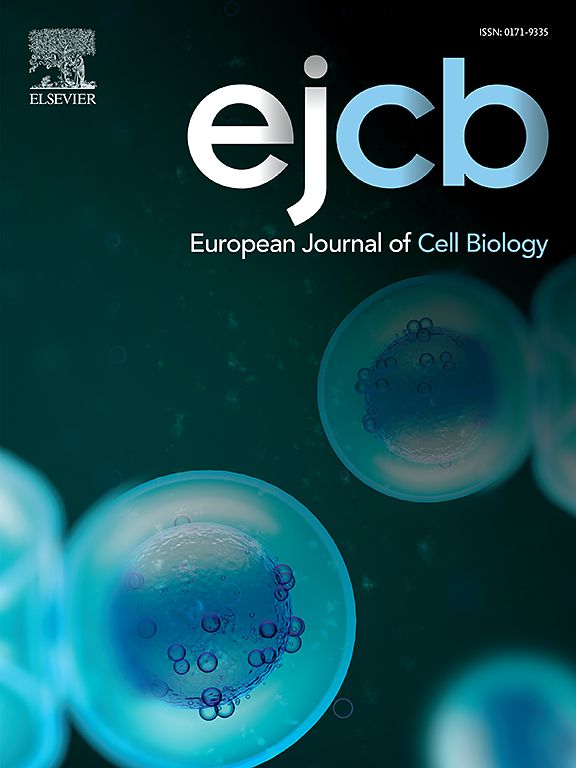The cortical actin cytoskeleton and desmosomes act together in keratin filament network maintenance
IF 4.3
3区 生物学
Q2 CELL BIOLOGY
引用次数: 0
Abstract
Keratin intermediate filaments are hallmark features of epithelial tissue differentiation forming complex cytoplasmic networks that are connected to subplasmalemmal cortical keratin filaments and anchored at desmosomal junctions. The mechanisms determining keratin filament network morphogenesis and maintenance are poorly understood. We previously generated a homozygous knock-in mouse line expressing YFP-tagged keratin 8, which functionally substitutes for the wild-type keratin 8. 3D time-lapse fluorescence recording of developing pre-implantation embryos allowed monitoring the de novo formation of the keratin filament network, which implicated desmosomes and the actin-rich cell cortex in nucleation and transport of nascent keratin particles. To further explore the relevance of the cell cortex for keratin filament network maintenance, we now studied Krt8-YFP-producing late blastocysts that had developed cytoplasmic and cortical keratin networks. We treated them with drugs to modulate the actomyosin cytoskeleton and analyzed desmosome-deficient blastocysts. We find that overall keratin network organization is barely affected in either scenario. Detailed analyses, however, reveal distinct changes in cytoplasmic keratin filament abundance, cortical anchorage and keratin filament turnover. We conclude that mature keratin networks withstand drastic changes in cellular organization and that maintenance of their spatial organization is secured in a “belt and braces” fashion by multiple mechanisms, notably desmosomal anchorage and attachment to the actin-rich cell cortex.
皮质肌动蛋白细胞骨架和桥粒共同作用于角蛋白丝网络的维持
角蛋白中间丝是上皮组织分化的标志性特征,形成复杂的细胞质网络,与质下皮层角蛋白丝相连,并锚定在桥粒体连接处。决定角蛋白丝网络形态发生和维持的机制尚不清楚。我们之前生成了表达yfp标记的角蛋白8的纯合敲入小鼠系,它在功能上替代了野生型角蛋白8。植入前胚胎发育的3D延时荧光记录允许监测角蛋白丝网络的新生形成,这涉及到桥粒和富含肌动蛋白的细胞皮层在新生角蛋白颗粒的成核和运输中。为了进一步探索细胞皮层与角蛋白丝网络维持的相关性,我们现在研究了产生krt8 - yfp的晚期囊胚,这些囊胚已经形成了细胞质和皮质角蛋白网络。我们用药物治疗它们来调节肌动球蛋白细胞骨架,并分析桥粒缺陷囊胚。我们发现,在这两种情况下,角蛋白网络的整体组织几乎没有受到影响。然而,详细分析显示细胞质角蛋白丝丰度、皮质锚定和角蛋白丝周转有明显变化。我们得出的结论是,成熟的角蛋白网络能够承受细胞组织的剧烈变化,并且其空间组织的维持是通过多种机制以“皮带和支架”的方式获得的,特别是桥粒锚定和附着于富含肌动蛋白的细胞皮层。
本文章由计算机程序翻译,如有差异,请以英文原文为准。
求助全文
约1分钟内获得全文
求助全文
来源期刊

European journal of cell biology
生物-细胞生物学
CiteScore
7.30
自引率
1.50%
发文量
80
审稿时长
38 days
期刊介绍:
The European Journal of Cell Biology, a journal of experimental cell investigation, publishes reviews, original articles and short communications on the structure, function and macromolecular organization of cells and cell components. Contributions focusing on cellular dynamics, motility and differentiation, particularly if related to cellular biochemistry, molecular biology, immunology, neurobiology, and developmental biology are encouraged. Manuscripts describing significant technical advances are also welcome. In addition, papers dealing with biomedical issues of general interest to cell biologists will be published. Contributions addressing cell biological problems in prokaryotes and plants are also welcome.
 求助内容:
求助内容: 应助结果提醒方式:
应助结果提醒方式:


